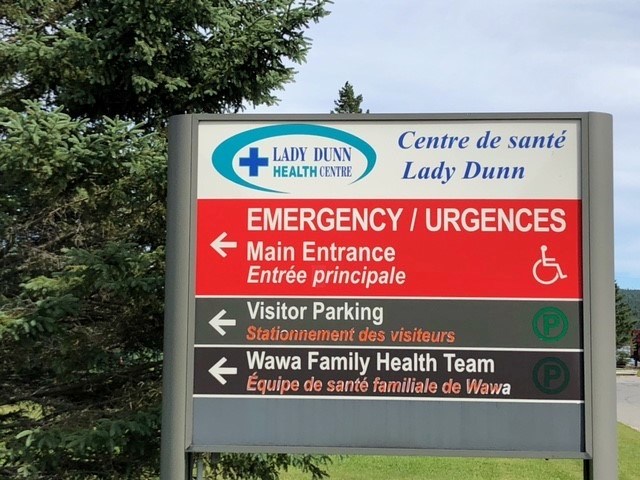In northern Ontario, family doctors are working long hours to keep the emergency rooms in their communities open.
For Dr. Anjali Oberai and her husband Dr. Mike Cotterill, that task is about to get harder at the Lady Dunn Health Centre emergency department in Wawa.
At one time there were six doctors available to work at Lady Dunn but that number will be down to two — Oberai and Cotterill — beginning in September.
“We will be the only two doctors to live and work here,” Oberai told SooToday in a recent telephone interview.
While emergency departments at hospitals across Ontario have closed temporarily over the past several months due to a shortage of doctors and nurses, such closures would be worse for patients in the north.
If a southern Ontario hospital closed its emergency department, another would be available not many kilometres away.
But if an emergency department closes in the north, it can be a two- to three-hour journey for a patient to the next closest emergency department.
“The horrors of an emergency department closure are magnified in the north, whether it be the hospital in Wawa, Manitoulin or Marathon. It’s hundreds of kilometres to the next emergency department. It’s dangerous for patients with life-threatening illnesses or injuries to travel that distance to seek care,” Oberai said.
“That's part of the reason why we really need to advocate for consistently funded locum support for both emergency and primary care.”
So far, Lady Dunn has been able to avail itself of locums to keep its emergency department open.
“We’ve been lucky to have locum support but if that were to stop we would be in an extremely difficult condition,” Oberai said.
Lady Dunn will have two to three locums to assist in a good week, she said.
“If we have consistently funded locum support we hopefully will be able to keep our emergency department open. To date we haven’t had to close it but there is unpredictability and uncertainty if we’ll have funding for locums and even if we can find locums,” Oberai said.
The Ontario College of Family Physicians and the OMA Section on General & Family Practice are calling for the province to:
-
Enhance locum program supports to ensure temporary doctors are available where they are most needed right now and introduce longer-term rethinking of how locums are used in the north.
-
Urgently fund recruitment programs to bring new physicians to the north.
-
Implement a comprehensive strategy and ensure positive working conditions to retain the remaining physicians in the north.
-
Provide immediate peer support for family doctors working in difficult conditions to maintain their mental health and well being.
“Northern Ontario is short about 200 family docs and about 110 are needed in our rural centres," Oberai said. "It’s really a crisis across the north."
Dr. Oberai and Dr. Cotterill have family medicine practices in Wawa apart from performing emergency department duties.
Oberai estimated she and her husband have approximately 1,000 patients each in their primary care provider practices.
She said she works five to six days a week, beginning at 7 a.m. and finishing by 5 p.m, with that routine accompanied by a lot of paperwork.
Oberai said she agrees with the recommendations made by Ontario College of Family Physicians and the OMA Section on General & Family Practice regarding the need for locums in northern Ontario, but added more needs to be done to make it more attractive for people to go into family medicine in the region.
“The job has gotten more complex,” Oberai said.
“I still really like it but there’s definitely more time required to manage a practice than there was in the past. People are living longer, their conditions get more complex, they need more medication, there’s more lab work, more paperwork. It’s become a more complicated job than it was 25 or 30 years ago.”
Oberai said many doctors would like to see more non-medical staff be added to doctors’ offices and hospitals to ease their workload.
“There’s more administrative duties, paperwork that takes up time when you could normally be seeing patients. Allowing doctors to work in a team environment where you have non-physician colleagues who have expertise in other areas, such as social workers and dietitians, would make work more enjoyable.”
Oberai said she would like to see more internationally trained doctors practicing in Canada, along with a pan-Canadian licence enabling doctors to freely practice across provincial borders.
Meanwhile, Sault Area Hospital’s emergency department has also avoided closure so far.
But working conditions for doctors and nurses aren’t easy.
“Our Emergency Department continues to see increased patient volumes, patients presenting who are more ill, and individuals who are unable to access urgent care with their primary care providers or are without a family care provider come to the Emergency Department for care. Like Emergency Departments across the country, we are impacted by increased patient visits coupled with staffing constraints. Patient wait times, ambulance offload delays, and admissions to the hospital have all increased," wrote SAH spokesperson Brandy Sharp Young in an email to SooToday.
“Our Emergency Department has a full slate of physicians, lessening the risk of physician shortages as seen elsewhere. We are reassured by this stable component of our care team. Like many communities across Canada, health human resources shortages are impacting the hospital. To lessen this impact, as our Emergency Department provides many levels of care, we redeploy staff and physicians to address the most critical patient care needs. We are working to address these shortages with recruitment initiatives,” Sharp Young wrote.
SAH is asking the public to support the hospital’s ED by seeking alternative care options such as visiting a walk-in clinic, contacting 811 (formerly Telehealth), or using a virtual care option.
In an emergency, members of the public are still instructed to call 9-1-1 or proceed to the Emergency Department and not delay care.
